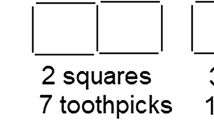abstract
We analyze the mathematical solutions of 7- to 8-year-old pupils while individually solving an arithmetic problem. The analysis was based on the “configuration of objects,” an instrument derived from the onto-semiotic approach to mathematical knowledge. Results are illustrated through a number of cases. From the analysis of mathematical solutions, we infer the use of iconic representations as a counting tool for the demonstrative nature of arguments developed by pupils.
Similar content being viewed by others
References
Barmby, P., Harries, T., Higgins, S. & Suggate, J. (2009). The array representation and primary children’s understanding and reasoning in multiplication. Educational Studies in Mathematics, 70(3), 217–241.
Bosch, M. A., Castro, E. & Segovia, I. (2007). El pensamiento multiplicativo en los primeros niveles: Una investigación en curso. PNA, 1(4), 179–190.
Carpenter, T., Ansell, E., Franke, M., Fennema, E. & Weisbeck, L. (1993). Models of problem solving: A study of kindergarten children’s problem-solving processes. Journal for Research in Mathematics Education, 24(5), 428–441.
Charles, K. & Nason, R. (2000). Young children’s partitioning strategies. Educational Studies in Mathematics Education, 43(2), 191–221.
Davis, G. & Hunting, R. P. (1990). Spontaneous partitioning: Pre-schoolers and discrete items. Educational Studies in Mathematics, 21(4), 367–374.
Edo, M., Planas, N. & Badillo, E. (2009). Mathematical learning in a context of play. European Early Childhood Education Research Journal, 17(3), 325–341.
Fagnant, A. & Vlassis, J. (2013). Schematic representations in arithmetical problem solving: Analysis of their impact on grade 4 pupils. Educational Studies in Mathematics. doi:10.1007/10649-013-9476-4.
Font, V., Godino, J. D. & Gallardo, J. (2013). The emergence of objects from mathematical practices. Educational Studies in Mathematics, 82, 97–124.
Fosnot, C. T. & Dolk, M. (2001). Young mathematicians at work: Constructing multiplication and division. Portsmouth, N.H.: Heinemann.
Fuson, K. & Li, Y. (2009). Cross-cultural issues in linguistic, visual-quantitative, and written-numeric support for mathematical thinking. ZDM-The International Journal on Mathematics Education, 41(6), 793–808.
Godino, J. D., Font, V., Wilhelmi, M. & Lurduy, O. (2011). Why is the learning of elementary arithmetic concepts difficult? Semiotic tools for understanding the nature of mathematical objects. Educational Studies in Mathematics, 77(2–3), 247–265.
Harries, A. & Barmby, P. W. (2007). Representing and understanding multiplication. Research in Mathematics Education, 9, 33–45.
Hegarty, M. & Kozhevnikov, M. (1999). Types of visual-spatial representations and mathematical problem solving. Journal of Educational Psychology, 91, 684–689.
Kintsch, W. & Greeno, J. (1985). Understanding and solving word arithmetic problems. Psychological Review, 92(1), 109–129.
Mulligan, J. & Mitchelmore, M. C. (1997). Young children’s intuitive models of multiplication and division. Journal for Research in Mathematics Education, 28(3), 309–330.
Novick, L. R. (2006). Understanding spatial diagram structure: An analysis of hierarchies, matrices, and networks. The Quarterly Journal of Experimental Psychology, 59(10), 1826–1856.
Nunes, T., Bryant, P., Burman, D., Bell, D., Evans, D. & Hallett, D. (2009). Deaf children’s informal knowledge of multiplicative reasoning. Journal of Deaf Studies and Deaf Education, 14(2), 260–277.
Pantziara, M., Gagatsis, A. & Elia, I. (2009). Using diagrams as tools for the solution of non-routine mathematical problems. Educational Studies in Mathematics, 72, 39–60.
Reusser, K. (1988). Problem solving beyond the logic of things: Contextual effects on understanding and solving word problems. Instructional Science, 17, 309–338.
Rubin, A., Storeygard, J. & Koile, K. (2013). Supporting special needs pupils in drawing mathematical representations. In Proceedings of the Workshop on the Impact of Pen and Touch Technology on Education (WIPTTE), March 21–23. Los Angeles and Malibu California: Pepperdine University.
Saundry, C. & Nicol, C. (2006). Drawing as problem-solving: Young children’s mathematical reasoning through pictures. In J. Novotná, H. Moraová, M. Krátká & N. Stehlíková (Eds.), Proceedings of the 30th Conference of the International Group for the Psychology of Mathematics Education (Vol. 5, pp. 57–63). Prague, Czech Republic: PME.
Smith, S. P. (2003). Representation in school mathematics: Children’s representations of problems. In J. Kilpatrick, W. G. Martin & D. Schifter (Eds.), A Research Companion to Principles and Standards for School Mathematics (pp. 263–274). Reston, VA: NCTM.
Uesaka, Y., Manalo, E. & Ichikawa, S. (2007). What kinds of perceptions and daily learning behaviors promote pupils’ use of diagrams in mathematics problem solving? Learning and Instruction, 17, 322–335.
Vicente, S., Orrantia, J. & Verschaffel, L. (2008). Influencia del conocimiento matemático y situacional en la resolución de problemas aritméticos verbales: Ayudas textuales y gráficas. Infancia y Aprendizaje, 31(4), 463–483.
Warfield, J. (2001). Teaching kindergarten to solve word problems. Early Childhood Educational Journal, 28(3), 127–138.
Woleck, K. R. (2001). Listen to their pictures: An investigation of children’s mathematical drawings. In A. Couco (Ed.), The roles of representation in school mathematics (pp. 215–227). Reston, VA: NCTM.
Author information
Authors and Affiliations
Corresponding author
Rights and permissions
About this article
Cite this article
Badillo, E., Font, V. & Edo, M. ANALYZING THE RESPONSES OF 7 – 8 YEAR OLDS WHEN SOLVING PARTITIONING PROBLEMS. Int J of Sci and Math Educ 13, 811–836 (2015). https://doi.org/10.1007/s10763-013-9495-8
Received:
Accepted:
Published:
Issue Date:
DOI: https://doi.org/10.1007/s10763-013-9495-8




